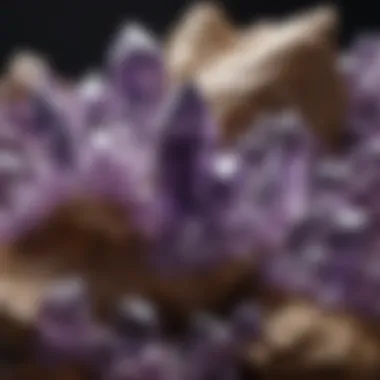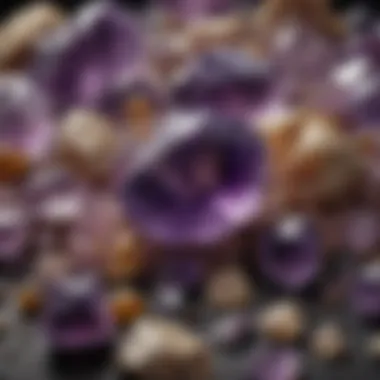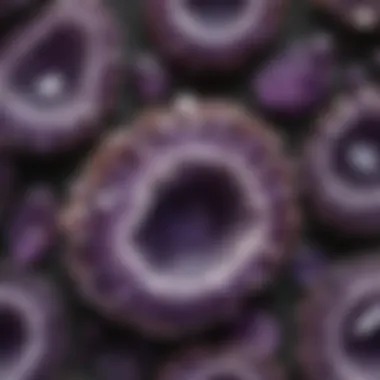Unveiling the Intriguing Pricing Patterns of Raw Amethyst Stones


Rock and Fossil Identification
Raw amethyst stones are a captivating part of the mineral world, with distinct characteristics that set them apart from other gemstones. When exploring the pricing of these mesmerizing geological treasures, it is crucial to understand the key factors that influence their value. Amethyst stones are a type of purple quartz, known for their vibrant hues ranging from light lavender to deep purple. The most sought-after raw amethyst stones exhibit intense color saturation, clarity, and size, which significantly impact their market price. Proper identification of these characteristics is essential for both collectors and enthusiasts.
Characteristics to Look for
When assessing the quality of raw amethyst stones, several key characteristics should be considered. The intensity and consistency of the purple coloration are primary indicators of value, with deeply saturated hues commanding higher prices. Clarity is another crucial factor, as stones without visible inclusions or fractures are more desirable. Additionally, size plays a significant role in determining the value of raw amethyst stones, with larger specimens generally commanding higher prices in the market.
Tools for Identification
To accurately identify raw amethyst stones and differentiate them from other minerals, collectors can utilize various tools. A magnifying loupe is invaluable for examining color saturation, clarity, and any internal flaws that may affect the stone's value. Additionally, a UV light can help reveal fluorescence properties unique to amethyst, aiding in its identification. Collectors should also reference reputable sources and guides to enhance their knowledge of raw amethyst characteristics and pricing trends in the market.
Introduction
The allure of raw amethyst stones is undeniable, sparking curiosity and fascination among rock and fossil collectors. This article embarks on a journey to explore the pricing intricacies of these mesmerizing geological wonders. By delving into the factors that influence raw amethyst prices, shedding light on the significance of quality and rarity, and unraveling the market trends shaping their value, readers will be equipped with a comprehensive understanding of the dynamics driving the pricing of raw amethyst stones.
Overview of Raw Amethyst Stones
Formation and Characteristics
Formation and characteristics play a pivotal role in the enchanting appeal of raw amethyst stones. These stones, typically formed in geodes or volcanic rock cavities, showcase stunning hues ranging from deep purples to delicate lilacs. The crystalline structure of amethyst creates unique patterns and inclusions, adding to the beauty and individuality of each piece. Collectors are drawn to the ethereal translucency and vibrant colors, making raw amethyst a sought-after choice for its natural elegance.


Appeal to Collectors
The appeal of raw amethyst to collectors lies in its enchanting beauty and metaphysical properties. With a history steeped in mysticism and healing traditions, amethyst holds a special place in the hearts of crystal enthusiasts. Its calming energy and spiritual significance make it a prized addition to any collection. The captivating allure of raw amethyst stones transcends mere aesthetic appeal, forming a deep connection with those who appreciate its innate qualities and symbolism.
Factors Influencing Pricing
Quality Grading
Quality grading serves as a cornerstone in assessing the value of raw amethyst stones, providing insights into their visual appeal and overall desirability. Within the realm of quality grading, several key aspects stand out, each contributing significantly to the stone's pricing.
Color Intensity
Color intensity is a defining characteristic of raw amethyst stones, with vibrant hues commanding premium prices in the market. The richness and depth of color play a pivotal role in determining the stone's allure and value. Deep purples and velvety textures are highly sought after by collectors, showcasing the finest quality in amethyst specimens. While intense coloration enhances the stone's beauty, it also signifies rarity, reflecting the geological conditions that yielded such striking pigmentation.
Clarity
Clarity is another imperative factor in quality grading, reflecting the transparency and flawlessness of the raw amethyst stone. Stones with high clarity exhibit few inclusions or blemishes, allowing light to pass through unimpeded, resulting in a mesmerizing play of reflections and refractions. Exceptional clarity signifies purity and adds to the overall brilliance of the stone, making it a coveted choice among connoisseurs seeking impeccable specimens.
Cut
The cut of a raw amethyst stone influences not only its visual aesthetics but also its market appeal and pricing. A precise cut enhances the stone's brilliance, maximizing its reflective properties and showcasing its natural beauty. Whether faceted for a dazzling display or left raw for a more organic allure, the cut plays a crucial role in accentuating the stone's intrinsic characteristics. Skilled craftsmanship in cutting raw amethyst stones can elevate their desirability and value, making them stand out in the competitive gemstone market.


Rarity and Availability
Rarity and availability further shape the pricing of raw amethyst stones, adding layers of complexity to their market valuation. The interplay between natural vs. enhanced stones and market demand offers insights into the factors driving price fluctuations and supply dynamics.
Natural vs. Enhanced
The classification of raw amethyst stones into natural or enhanced categories has a significant impact on their pricing and desirability. Natural stones, formed through geological processes over millions of years, embody unique characteristics and exceptional beauty, making them rare and highly coveted. Enhanced stones, on the other hand, undergo treatments to improve color or clarity, altering their natural state to meet market demands. While enhanced stones may exhibit enhanced visual appeal, natural specimens hold a special allure for collectors seeking authenticity and exclusivity.
Market Demand
Market demand plays a pivotal role in shaping the pricing of raw amethyst stones, reflecting consumer preferences and industry trends. Fluctuations in demand can influence prices, driving both scarcity and abundance in the market. Understanding the ebb and flow of market demand is vital for gauging the value of raw amethyst stones, as collector's preferences and global trends shift over time. By staying attuned to market dynamics, enthusiasts can make informed decisions when navigating the complex landscape of raw amethyst pricing, ensuring they acquire stones of both intrinsic value and enduring appeal.
Market Trends
In the realm of raw amethyst stones, comprehending market trends is imperative to grasp the dynamic landscape of this coveted gemstone industry. Market trends serve as barometers for gauging demand, pricing variations, and overall market health. By analyzing market trends, enthusiasts, collectors, and investors can make informed decisions, whether for personal enjoyment or investment purposes. Understanding the ebbs and flows of the market provides valuable insights into when to buy, sell, or hold onto raw amethyst specimens.
Global Market Analysis
Supply Chain Dynamics
Delving into the supply chain dynamics of raw amethyst stones unveils a complex web of processes and stakeholders involved in bringing these geological marvels to market. From mining operations to wholesale trading, each step in the supply chain influences availability, pricing, and quality. The efficiency and transparency of the supply chain directly impact the accessibility of raw amethyst stones to consumers worldwide. Embracing sustainable practices within the supply chain is paramount to ensuring the ethical sourcing and distribution of these gems.


Price Fluctuations
Price fluctuations in the raw amethyst market reflect the ever-changing forces of supply and demand, underlining the dynamic nature of this niche industry. Factors such as seasonal variations, global economic conditions, and geopolitical events can all contribute to price shifts in the raw amethyst sector. Understanding the reasons behind price fluctuations empowers stakeholders to navigate market volatility strategically. While fluctuations may present risks, they also offer opportunities for astute collectors and investors to capitalize on favorable pricing trends.
Investing in Raw Amethyst
Within the realm of raw amethyst stones, investing represents a crucial avenue that enthusiasts and collectors delve into. This section of the article delves deeply into the significance of investing in raw amethyst, offering a comprehensive guide on the various elements, benefits, and considerations associated with this intriguing aspect.
Investing in raw amethyst goes beyond mere ownership; it embodies a strategic decision that can yield both personal satisfaction and potential financial returns. For individuals deeply passionate about geological wonders, investing in raw amethyst allows them to not only expand their collection but also participate in the dynamic market surrounding these precious stones.
One key element to consider when delving into investments in raw amethyst is the resilience of these stones as an asset. Amethyst, with its timeless appeal and enduring popularity among collectors, holds the promise of maintaining and potentially appreciating in value over time. This characteristic makes investing in raw amethyst a compelling choice for those looking to combine their love for natural beauty with a tangible investment opportunity.
Moreover, investors exploring raw amethyst stones are also drawn to the element of intrinsic value that these gems possess. The rarity and unique beauty of amethyst contribute to its allure in the market, making it a coveted choice for collectors seeking exclusivity and distinction in their portfolios.
In essence, investing in raw amethyst offers a multifaceted avenue for enthusiasts to not only nurture their passion for these geological treasures but also partake in a market brimming with opportunities for growth and appreciation.
Conclusion
In this intricate exploration of raw amethyst stone pricing, a culmination in the conclusion serves as a pivotal point to synthesize the nuanced information unveiled throughout the article. Understanding the price dynamics of raw amethyst stones is crucial for collectors and investors alike, as it provides insight into the factors shaping the market for these mesmerizing geological treasures. The conclusion acts as a compass, guiding readers towards making informed decisions regarding these exquisite stones.
Key Takeaways
Appreciating the Artistry
Delving into the realm of raw amethyst stones reveals a deep appreciation for the artistry inherent in their formation. From their captivating color variations to the intricate patterns within, the artistry of raw amethyst stones transcends mere geological significance. This aspect not only adds a layer of aesthetic allure to the stones but also signifies the intricate processes that lead to their creation. Such artistry enhances the overall beauty of raw amethyst stones, making them a sought-after choice for collectors and enthusiasts looking for natural marvels that inspire awe.
Informed Buying Decisions
Empowering oneself with knowledge about raw amethyst stone pricing enables making informed buying decisions a key aspect for enthusiasts in their pursuits. Understanding the quality factors, rarity indicators, and market trends plays a vital role in ensuring that every purchase is a carefully analyzed investment. Knowledge equips buyers to differentiate between stones of varying worth, thereby ensuring that each acquisition aligns with their preferences and budget. Making informed buying decisions is not just about acquiring raw amethyst stones; it is about immersing oneself in a world of geological wonders with prudence and discernment.







